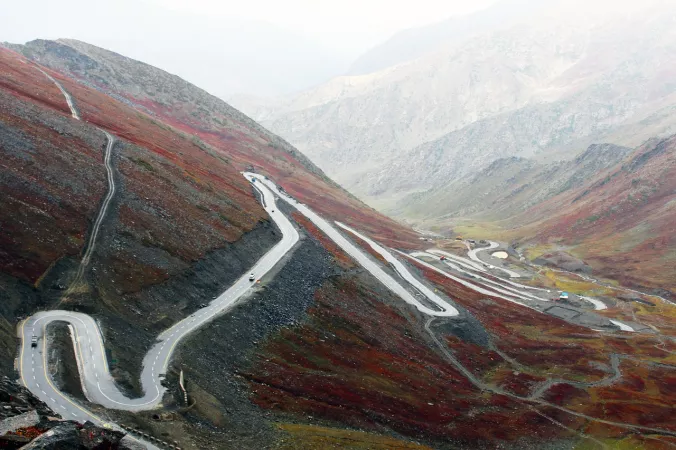
Kunzum Pass Travel Guide
Kunzum Pass is a high-altitude mountain pass located in the Indian state of Himachal Pradesh. Situated at an elevation of 4,590 meters above sea level, it connects the Kullu Valley and Lahaul Valley with the Spiti Valley. The pass is renowned for its breathtaking views of the surrounding snow-capped peaks, pristine glaciers, and rugged terrain. Kunzum Pass holds great cultural significance as it is a gateway to the remote and mystical Spiti Valley, known for its ancient monasteries and unique Tibetan culture. This historical route has been used for centuries by traders and pilgrims traveling between the valleys.Top Attractions in Kunzum Pass
- Spiti Valley
- Chandratal Lake
- Key Monastery
- Kunzum Devi Temple
- Bara Shigri Glacier
Kunzum Pass is Famous for
Its rugged terrain, stunning views, and cultural significance.Top Attractions in Kunzum Pass
- Explore the ancient Key Monastery
- Trek to Chandratal Lake
- Visit the Kunzum Devi Temple for blessings
- Experience the unique culture of Spiti Valley
- Witness the majestic Bara Shigri Glacier
What's Great about Travelling to Kunzum Pass?
- Adventure enthusiasts seeking offbeat destinations
- Nature lovers looking for pristine landscapes
- Cultural explorers interested in Tibetan heritage
What's Not So Great about Travelling to Kunzum Pass?
- Not recommended for travelers with altitude sickness
- Limited facilities and accommodations in remote areas
- Challenging road conditions and unpredictable weather
Travel Tips for Kunzum Pass
- Carry essential medications for altitude sickness
- Check weather conditions before traveling
- Be prepared for basic amenities and limited connectivity
Important Kunzum Pass trip information
- Ideal Duration: 3-5 days to explore the area
- Best Time to Visit: June to September for pleasant weather
- Nearby Airports and Railway Stations: The nearest airport is in Kullu and the closest railway station is in Shimla
FAQ's on Kunzum Pass
Q1: What is the best time to visit Kunzum Pass?
The best time to visit Kunzum Pass is during the summer months from June to September when the weather is pleasant, and the pass is accessible. It is important to avoid the winter months due to heavy snowfall and road closures. Travelers should also consider attending local festivals and events that take place during the summer season.
Q2: Do I need a visa to travel to Kunzum Pass?
Travelers to Kunzum Pass will need a valid Indian visa as the pass is located in the Indian state of Himachal Pradesh. Visitors should check the specific visa requirements based on their nationality and ensure their documents are in order before traveling.
Q3: What are the must-visit attractions in Kunzum Pass?
Kunzum Pass offers breathtaking views of the surrounding Himalayan mountains, making it a must-visit for nature lovers and adventure enthusiasts. Other attractions include the stunning Chandratal Lake, Key Monastery, and the scenic Spiti Valley.
Q4: Is Kunzum Pass a safe place to travel?
Kunzum Pass is generally safe for travelers; however, it is essential to be cautious while driving on the mountain roads due to steep cliffs and rugged terrain. Travelers should also be aware of altitude sickness and take necessary precautions.
Q5: What is the local currency in Kunzum Pass and can I use credit cards?
The local currency in Kunzum Pass is the Indian Rupee (INR). While credit cards may be accepted in some hotels and larger establishments, it is advisable to carry cash as ATMs may not be readily available in remote areas.
Q6: What is the local cuisine like in Kunzum Pass?
The local cuisine in Kunzum Pass is influenced by Tibetan and Himalayan flavors, with dishes like thukpa (noodle soup), momos (dumplings), and butter tea being popular choices. Travelers can also enjoy local organic produce and dairy products.
Q7: What transportation options are available in Kunzum Pass?
Transportation options in Kunzum Pass include public buses, shared jeeps, and private taxis for local travel. Travelers can also rent motorcycles or cars to explore the region at their own pace.
Q8: Are there any cultural norms or etiquette I should be aware of when visiting Kunzum Pass?
When visiting Kunzum Pass, travelers should respect the local customs and traditions of the Tibetan and Himalayan communities. It is important to dress modestly, remove shoes before entering homes or temples, and greet locals with a and .
Q9: I am a travel agent. How can I buy travel leads of Kunzum Pass?
Register yourself as a travel agent at agents.tripclap.com and then you can buy travel leads to Kunzum Pass once your account is approved. For more details contact our support team at +91-8069186564 or support@tripclap.com
